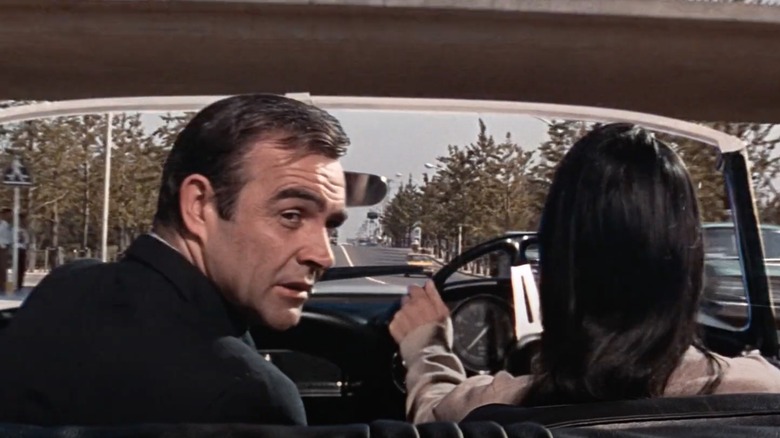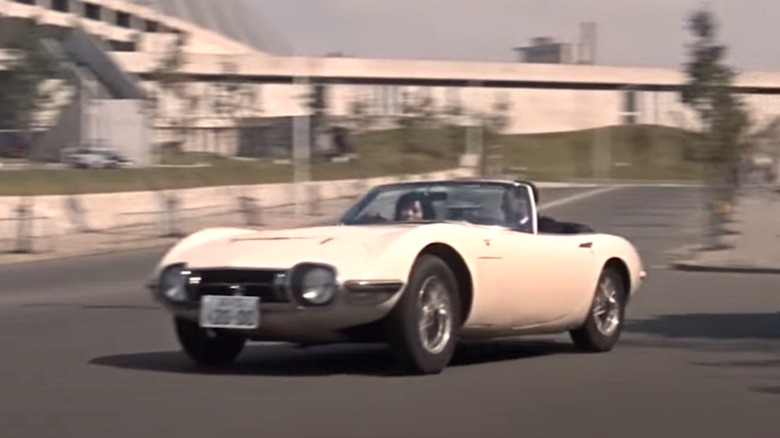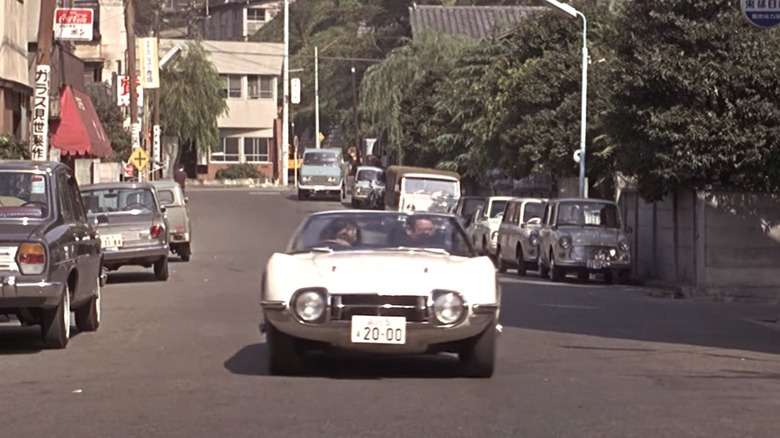Yamaha Played A Crucial Role In Creating This Iconic James Bond Car
Few film franchises without the word "Fast" in the title have indulged in automotive delights quite as much as the James Bond series. Over the course of its 27-films-and-counting run, Agent 007 has driven a parade of legitimately show-stopping vehicles, most of which have been tricked out with all manner of slick, if slightly silly super spy gadgetry. So too have many of the cars driven by Bond's allies and adversaries, with some piloting vehicles made by brands far from the super spy's typical high-end European preferences.
Bond's non-Euro build beat was, perhaps, best embodied in 1967's "You Only Live Twice," which found 007 setting off to Japan and partnering with Secret Service agents to stop a series of space-bound attacks spearheaded by the villainous Blofeld (Donald Pleasance) and his nefarious SPECTRE faction. One of Bond's key Secret Service collaborators was an agent named Aki (Akika Wakabayashi), who saved his hide on more than one occasion by spiriting him away in her souped-up Toyota 2000 GT.
Though the vehicle isn't always listed amongst the most iconic sportsters to grace the greater Bond-verse, Aki's 2000 GT more than made a statement when it first sped into the action. While regarded in some circles as Japan's first legit supercar, Toyota's 2000 GT likely would not have come into existence without a few key contributions from another iconic Japanese brand, Yamaha.
Yamaha helped shape the look of the 2000 GT before its Bond debut
Yamaha is not generally a name associated with cars, with the manufacturer perhaps better known for building motorcycles and pianos in the 1960s. It seems, however, that Yamaha had a keen interest in the automobile scene of the era. While Yamaha never quite found its footing in the auto arena, it did seek out partnerships with other car manufacturers in hopes of getting its proverbial feet wet. That included a mid-60s partnership with Toyota, which indeed led to the development of the sporty 2000 GT that turned up in "You Only Live Twice."
The road to the 2000 GT's big screen Bond debut was relatively short, with Yamaha and Toyota first officially teaming up in 1965 and prototypes debuting later that same year. When Yamaha abandoned its own GT designs, Toyota brass tapped the already legendary motorcycle company for help in getting its 2000 GT in fighting shape. While Toyota took point on the overall design of the vehicle — taking inspiration from the Lotus Elan — when it came time to build prototypes of the manufacturer's first supercar, Yamaha took the designs and set to creating full sized diagrams and producing wood frames to display the sheet-metal body.
Part of that involved Yamaha employing FRP (Fibre Reinforced Polymer) molding techniques it developed for boat making for the vehicle's iconic long hood and short trunk design. Yamaha techs even utilized similar methods to those used in piano making on the wood inlays for the 2000 GT's sleek interior.
A a few Yamaha tweaks got the 2000 GT's in supercar shape under the hood
While Yamaha technicians helped frame up Toyota's 2000 GT body and detail its interior, it's safe to say the company's biggest impact on the vehicle's powered-up appeal came under the hood. Some might even argue it was the Yamaha team that helped the 2000 GT reach its potential in the power department.
Working with one of Toyota's water-cooled, 2000 cc in-ine six cylinder builds previously used in the Toyopet Crown, Team Yamaha converted the engine DOHC (Dual Overhead Camshaft) style hoping to increase its output. The move paid off, with the re-worked engine now pushing a whopping 150 horsepower. The mix of power and style on display in Toyota's 2000 GT when it hit the streets made it an ideal vehicle to feature in the 007 verse, even if the famed super spy didn't actually drive it himself.
Before the vehicle hit the big screen, Toyota sought to prove the vehicle's Grand Touring credentials on the track, conducting three days of speed trials in 1966 that resulted in the 2000 GT breaking 3 world records and 13 international records held by vehicles in its class. However, even with that on-track accolade and a Hollywood spotlight, the supercar was not a super seller for the company, with Toyota reportedly moving just 337 production models between 1967 and 1970. Nonetheless, they are now sought after artifacts in the vintage car market, with 2000 GT's commanding considerably more money on resale than they did fresh off the line.


